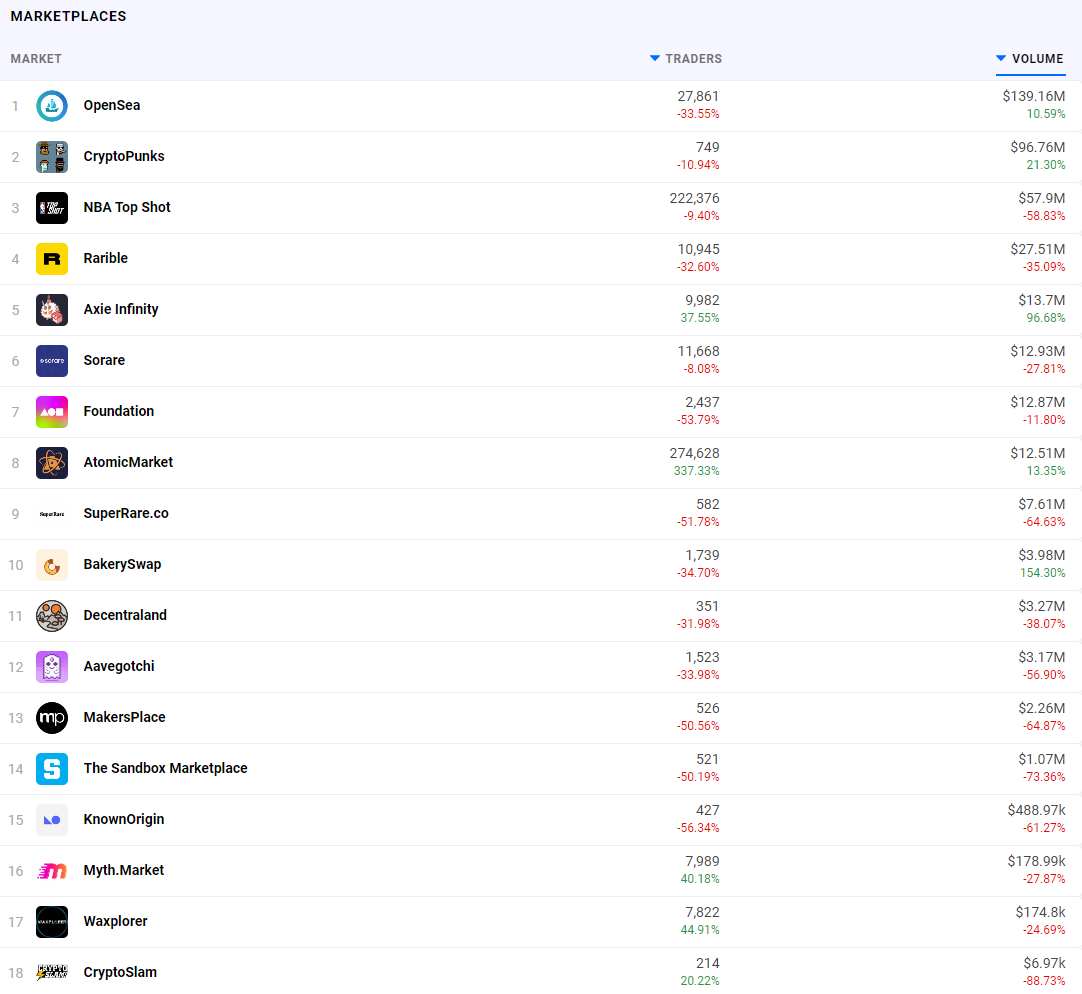News
As the Hype Dies Down, What’s Next for NFTs?
Summary: The NFT hype from Spring 2021 has begun to finally wind down, as many of the top NFT marketplaces have seen a staggering decline in monthly volume. Even though the days of virtual trading cards and artworks fetching multi-million dollar price tags might be over, there is still extremely high potential for NFTs in gaming, ...
The NFT hype from Spring 2021 has begun to finally wind down, as many of the top NFT marketplaces have seen a staggering decline in monthly volume. Even though the days of virtual trading cards and artworks fetching multi-million dollar price tags might be over, there is still extremely high potential for NFTs in gaming, utility, and with real-world assets.
In the early part of 2021, NFTs were the biggest alternative investment, and got coverage from all sorts of mainstream news outlets, like the Wall Street Journal and CNBC. They became so popular that people flocked to digital assets as a way to hedge against the uncertainty in the market, in a way similar to how people invest in trading cards or celebrity autographs. However, these levels of hype have died down significantly over the past couple of months. For example, NBA Top Shot, once the premiere NFT trading card platform, has seen the prices for some cards go down by 50% or more from their all-time highs. It is no longer possible to create an NFT out of thin air and demand multiple ETH for it, which was once possible when investors of no knowledge in the space were buying everything they could get their hands on.

Fortunately, this does not spell the end for NFTs. Even though the trading card-esque NFTs with no underlying value were the most popular, there are many other forms of less popular NFTs that still have potential to create mainstream adoption and have real world use cases.
One example of these types of NFTs are the utility NFTs seen in gaming and other sectors. For example, ZED RUN is a platform that allows people to buy, sell, race, and breed digital horses. These horse NFTs offer more than just a collector’s item, but a real asset with profit-making potential. The horses can earn money in races, which are streamed on ZED’s Twitch page for thousands of viewers, or be bred with other horses to make new ponies that can be sold on a secondary market or raced. These types of projects show that there is still lots of potential in the utility of NFTs, and that they can do much more than simply be a piece of art or a trading card.

Another area related to gaming that NFTs are changing are cosmetic items in video games. Even though it seems crazy to some to spend real world money on video game cosmetic items, it is a billion-dollar industry, and is only poised to grow as gaming and esports in general continues to skyrocket in popularity. With NFTs, cosmetics and weapon skins can be taken from game-to-game, and sold on a secondary market instead of being a sunk cost by an individual. Enjin Coin is the main project building this gaming ecosystem. They have a marketplace where gamers can trade cosmetic items and weapons that can be used in a multitude of games. For example, there is a Binance hoodie item that can be used in a blockchain-based mobile game, Minecraft, and a web-based game. If this technology was adopted by a large game such as Fortnite or World of Warcraft, NFTs would see a massive increase in adoption, and game publishers would be able to make a lot more money off their cosmetic items due to the hype surrounding NFTs.

One of the more practical areas that can be disrupted by NFT technology is the tethering of items to digital assets. In our modern society, owning a house means that one owns a paper-based land deed giving the owner rights to a piece of land. There is no reason that this paper document cannot be substituted for one on the blockchain, which would allow its owner to have much more flexibility and security over its transfer. This application extends beyond real estate and into any asset that can be owned. On the blockchain, tokenized items could be bought, sold, and transferred with ease, or broken up into coins representing shares in the item and used in DeFi protocols.
Not only could tangible items be stored as NFTs, but also digital media, such as songs, books, and movies. This is especially relevant in the field of college textbooks. Right now, illegally downloading and sharing digital textbooks is incredibly easy. In order for publishers to make money, they have no choice but to offer their textbooks as digital subscriptions, which is incredibly student unfriendly: students have to pay the same price for the textbook, but it only lasts a semester, as opposed to forever. If publishers minted their books as NFTs, students could buy them, then sell them to another student at the end of the semester, and due to the nature of the blockchain, it could not be duplicated and illegally shared. This offers a win-win situation, as publishers get to continue making profits without the worry of forgery, and students get to truly own their digital assets.
Even though it’s easy to get caught up in the hype of trading card and other functionally useless NFTs, the truth is that the real value lies in the potential for NFTs to be used in a multitude of different ways. As NFTs continue to grow in popularity and more companies and other entities begin taking advantage of their revolutionary immutable and blockchain-based properties, they will begin to become nearly universal in our everyday lives.
By Lincoln Murr
Tags: Blockchain,ENJ,Enjin,Gaming,NFT,real estate,Zed Run
Link: As the Hype Dies Down, What’s Next for NFTs? [Copy]